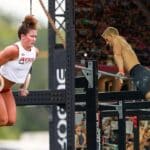Are you wondering how often should you deadlift? The ideal deadlift frequency depends on variables like your goals, experience, availability, and training program. Understanding these concepts will put you in the right place to determine your deadlift frequency.
Once you have a hold of those variables, putting together the workout plan should be the easy part.
In this article I’ll cover the main factors that affect your deadlift frequency and how you can adapt this exercise to your daily life, even if you can only workout once a week.
Here’s what you’ll learn:
- How to Determine Your Deadlift Frequency
- Types of Deadlifts To Vary Your Deadlift Routine
- When NOT to Increase Your Deadlift Frequency
- How To Include Deadlift In Your Training Routine
Let’s dive in!
Jump to:
How To Determine Your Deadlift Frequency
The number of times you can deadlift throughout the week depends on variables like your goals, experience, availability, and training program.
So, let’s go through them in depth to help you choose the ideal frequency that fits your daily life the most.
1. Know Your Goals
Most people should start by asking themselves what they are trying to accomplish with their training. Based on that, you’ll get a solid idea of where to start.
For example, if your goal is no more than to stay healthy, then deadlifting once a week may be enough. But if you’re interested in powerlifting or bodybuilding, consider deadlifting 3-4 times a week.
Ask yourself, “what am I looking for with training?” and go from there!

2. Training Experience
The amount of experience you have in training will also determine how many times per week your body can deadlift. Remember that deadlifts recruit many muscle fibers on every rep, and they will tax you after every session.
For beginners, deadlifting 1-2 times per week should give their bodies enough time to recover and attack the next session with enough intensity.
More experienced lifters can handle 3-4 sessions a week without compromising joint health and still get desired results.
Start small, be patient, and aim for steady progress.
3. Training Availability
Even if you’re clear about your goals and have the proper training experience, it all boils down to the amount of time you have available for training.
Nowadays, it’s common to see people with multiple jobs and ever-changing schedules, which makes training adherence a real challenge.
If you can only train three times per week and want to get stronger, try to add deadlifts on all three sessions but with different intensities.
For example:
– Day 1 (high volume – mid intensity): 5 sets, 6-8 reps at 70-80% of your 1 rep max.
– Day 2 (low volume – low intensity): 2 sets, 4-6 reps, 60-70% of your 1 rep max.
– Day 3 (high volume – high intensity): 4-5 sets, 8-10 reps at 80-90% of your 1 rep max.
Although these numbers will vary over time, they should give you an idea of where to start.
4. Programming
Programming is what dictates what you do at the gym. In other words, the recipe holds the chef’s meals.
Whether you’re following someone else’s programming or doing it yourself, be mindful to consider all the variables above to ensure you’re on track for sustainable progress.

Types of Deadlifts To Vary Your Deadlift Routine
The deadlift has many variations that can help you target different muscles and keep your training routine fun and effective. Below are some of them and how to include them.
Romanian Deadlift
The Romanian deadlift (RDL) is one of the most utilized variations of the deadlift due to its long range of motion, which is ideal for developing the hamstrings, glutes, and spinal erectors. Even if you’re deadlifting once a week, include them to maximize your lower-body gains.
Trap Bar Deadlift
The trap bar deadlift uses a hexagonal-shaped bar (hex bar), allowing the lifter to step inside and lift the bar.
It’s a significant variation that requires less range of motion, targets more quads, and is easier to learn than other barbell deadlifts. On top of that, trap bar deadlifts are also safer for your spine and allow for more sport-specific training.
Single Leg Deadlift
Single-leg deadlifts are a significant variation that allows beginner and advanced athletes to focus on muscular hypertrophy and balance without relying on heavy weights.
It’s one of those movements you can safely include every week without putting that much strain on your back.
Conventional Deadlift
The conventional deadlift is considered the king of deadlifts because of its large muscle recruitment compared to other variations.
This variation will target the glutes, hamstrings, spinal erectors, lats, and traps on every rep.
Dumbbell Deadlift
The dumbbell deadlift follows the same movement pattern as the conventional deadlift, with the only difference of using dumbbells instead of barbells.
It’s a fantastic deadlift variation for a beginner lifter that wants to progress steadily while keeping injury risk at a minimum.
Sumo Deadlift
The sumo deadlift takes its name from the initial stance seen in Japanese sumo wrestlers. This stance allows for a shorter range of motion while keeping a more upright torso compared to the conventional and Romanian deadlift.
This variation will also recruit muscle fibers from your adductors and upper back.
Deficit Deadlift
The deficit deadlift is a conventional deadlift with a greater range of motion. In this variation, the lifter steps on top of an elevated surface (2-4″), allowing the barbell to travel a longer distance.
This is a terrific variation to achieve more muscle recruitment from the hamstrings, glutes, and spinal erectors.
When NOT to Increase Deadlift Training Frequency
Frequency is the training variable that determines the number of working sessions you manage to handle per week.
Depending on your fitness level and goals, you can get away with 1-3 deadlift sessions per week. In the beginning, most people work their way up, going from deadlifting once a week to three or more.
However, increasing the deadlift training frequency is not always the right move. Below we share four scenarios where you should consider decreasing the frequency to yield the best results in the long run.
1. If You’re Prone To Injury Or Currently Have An Injury
Dealing with different types of injuries is always a challenge for most people. They represent a combination of patience, smart training, and professional help.
If you’re prone to injury or have a low-back injury, decreasing the deadlift sessions per week may be a good call.
It doesn’t mean you have to stop deadlifting altogether, but just enough to lower the intensity level and allow your body to recover properly. For some people, this could mean doing a deadlift once a week; for others, it could be more.
Strenuous workouts can get in the way of healing an injury. Limiting the weekly sessions and aiming for a more optimal training frequency until your body is ready to handle heavier deadlift sessions again.

2. If You’re Not Getting Enough Rest
If you’re not getting enough rest between training sessions, your body won’t be able to recover properly. This can decrease your training intensity and volume, getting in the way of your goals.
Failing to include at least a rest day during the week can also increase injury risks by overtraining the muscles and the mind.
You should add 1-3 days of rest throughout the week, depending on your fitness level, to allow your body to get the rest it needs.
3. Your Nutrition Is Subpar
Nutrition is the crucial element of any health and fitness goal. For most people, it’s the most critical variable they need to take care of.
It is through nutrition and rest that the body can adapt to the training stimulus. The right foods will set you in the right direction to get the most out of your workout.
When you’re not eating enough or eating the wrong foods, your body won’t respond to how it needs to overcome the deadlift sessions.
Prioritize protein, and learn how to balance carbs, fats, and sugar. Combining this with an ideal recovery time should gradually get you closer to your training goals.
4. You’re Looking To Deload
A deload means lowering the training variables such as volume, intensity, and frequency to let the mind and body adapt and recover from the training program.
You want to focus on deadlifting fewer times per week in these scenarios. If you were doing deadlifts 2-3 times per week, lower the frequency to 1-2 workouts per week.
There is no deload if you’re not lowering the frequency of training.

How To Include Deadlift In Your Training Program
Once you have determined your ideal deadlift frequency, follow this essential guide to help you navigate the exercise routine and gain maximum strength.
1 Time Per Week Deadlift
If you’re deadlifting once a week, make sure to deadlift heavily. Focus on a high volume-high intensity session to promote the greatest amount of muscle growth and strength.
For example, 4-5 sets, 8-12 reps
- A1) Conventional deadlift (80-90% of your 1 rep max)
- A2) Dumbbell deadlift
- A3) DB Bent Over Row
- B1) Single Leg Deadlift
- B2) DB Box Step Up
- B3) DB Walking Lunges
- C1) Romanian Deadlift
- C2) Glute Bridges
Make sure to rest 120-180 seconds between sets to maximize your efforts. Pick the heaviest weights that allow you to do between 8-12 reps and keep the form in check.
2 Times Per Week Deadlift
A two times per week split can help you achieve your deadlift goals by keeping a high volume-high intensity session daily. Such as the following:
Day 1: 3-5 sets, 8-12 reps
- A1) Romanian Deadlift (70-80% of your 1 rep max)
- A2) DB Deadlift
- A3) Glute Bridge
- B1) Single Leg Deadlift
- B2) DB Bulgarian Split Squat
- B3) Leg Curls
- C1) 5 sets of speed deadlifts (trap bar deadlifts with 30-40% of your 1 rep max)

Day 2: 3-4 sets, 8-12 reps
- A1) Conventional Deadlift (80-90% of your 1 rep max)
- A2) Barbell Good Morning
- B1) Barbell Hip Thrust
- B2) DB Romanian Deadlifts
- C1) Single Leg Deadlift
- C2) Single Leg Curl
Get enough rest (1-3 minutes) between sets to help you stay fresh and primed for the next session.
3 Times Per Week Deadlift
Deadlifting three times per week is common in advanced lifters because their bodies are used to the volume and intensity.
If you’re a beginner or intermediate, keep the training load to 1-2 times per week before including a third day.
A 3-day split can look like this:
Day 1: 4-5 sets, 8-12 reps (high volume-high intensity)
- A1) Romanian Deadlift (70-80% of your 1 rep max)
- A2) DB Deadlift
- A3) Glute Bridge
- B1) Single Leg Deadlift
- B2) DB Bulgarian Split Squat
- B3) Leg Curls
- C1) 5 sets of speed deadlifts (trap bar deadlifts with 30-40% of your 1 rep max)
Day 2: 2-3 sets, 7-10 reps (low volume-mid intensity)
- A1) Conventional Deadlift (60-70% of your 1 rep max)
- A2) Barbell Good Morning
- B1) Barbell Hip Thrust
- B2) DB Romanian Deadlifts
- C1) Single Leg Deadlift
- C2) Single Leg Curl
Day 3: 3-4 sets, 4-6 reps (low volume-high speed)
- A1) Trap Bar Deadlift (50-60% of your 1 rep max)
- A2) DB Goblet Jumping Squat
- B1) Sumo Deadlifts (50-60% of your 1 rep max)
- B2) Alternating Jumping Squats
- C1) Deadbugs
- C2) Superman Hold
Although this guide is a solid start for most people, feel free to tweak it and adapt it to your training goals and experience levels.
Double down on your technique, and be patient with your results!

FAQ
Is Deadlifting 3 Times A Week Too Much?
Deadlifting three times a week is not necessarily too much. If you’re an experienced lifter, you’ll know how to handle the volume and intensity of every training session. However, if you’re a beginner, keep it between 1 and 2 times per week to allow the body to recover.
How Long Should You Wait Between Deadlift Days?
It would help if you waited at least one full day between deadlift days. This will give you more time for your body to rest and keep a low injury risk. Even two full days if you’re a beginner or someone coming from an injury.
How Often Should You Deadlift To Increase Strength?
It all depends on how much experience you have with lifting weights. If you’re a beginner, deadlifting, even one time a week, will gradually increase strength because you need less training volume.
Intermediate and experienced lifters usually deadlift between two and three times per week. That is because their bodies are used to the training volume and intensity.














